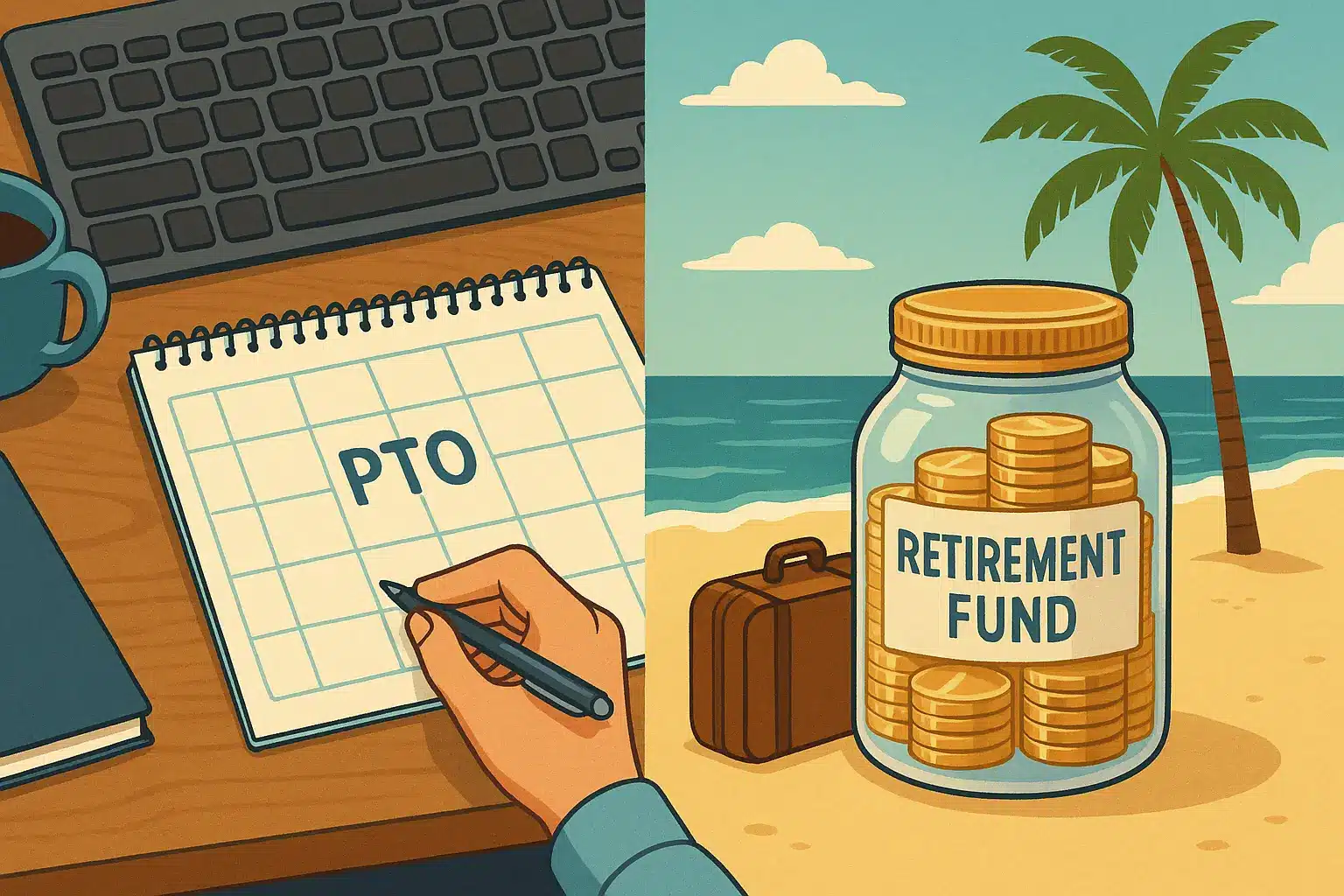Introduction: Why PTO and Retirement Belong in the Same Conversation
For most people, vacation days and retirement plans seem like unrelated benefits. One is about taking a break now, the other about financial security decades later. But dig deeper, and you’ll find a strong connection.
Your paid time off (PTO) policy directly influences your long-term savings potential, your career longevity, and even your retirement timeline. In 2025, as more companies rethink “unlimited PTO” policies dropping from 8.8% of job ads in 2022 to just 2.9% this year job seekers and employers alike are asking: Is unlimited PTO truly a perk, or is it a hidden pitfall for retirement planning?
What “Unlimited PTO” Really Means
Unlimited PTO usually means you don’t accrue vacation days or sick leave — you can request time off whenever you want, subject to your manager’s approval and performance expectations.
Key differences from traditional PTO:
- No accrual = no payout when you leave the company (in most cases).
- Time off is often informally tracked, so there’s less clarity on how much is “too much.”
- The benefit relies heavily on company culture — without strong encouragement, employees may take less time off than under capped systems.
Unlimited PTO: Pros and Cons (with a Retirement Lens)
Here’s how the unlimited PTO pros and cons debate shifts when you factor in retirement planning.
| Pros | Cons |
|---|---|
| Flexible scheduling — easier to manage caregiving or part-time phased retirement | No accrued payout at termination (can mean thousands less in savings) |
| Can reduce burnout — may help you work longer before retiring | Ambiguity — employees often take fewer days than with capped PTO |
| Signals trust and autonomy — attractive to some high-skill candidates | Lost opportunity to roll unused PTO value into retirement accounts |
| Simplifies HR administration and compliance | Uneven usage across teams; can create resentment |
Retirement impact takeaway: Unlimited PTO might help you stay healthy enough to work longer, but without accrual payout, you miss a potential lump sum that could boost your 401(k) or IRA contributions.
How PTO Policies Affect Retirement Savings
Even though PTO and retirement seem unrelated, they intersect in subtle but important ways:
- Accrued PTO = Hidden Savings
In traditional PTO setups, unused days can be cashed out when you leave. For a high earner with 20 days unused, that could mean a $5,000+ boost to savings — money you could directly invest toward retirement. - Unlimited PTO = No Cash-Out
Since there’s no accrual, there’s typically no payout. Leaving after 10 years could mean missing out on tens of thousands in extra retirement contributions. - Burnout and Early Retirement
Limited or underused PTO can accelerate burnout, sometimes pushing workers to retire earlier — reducing both total earnings and time for retirement savings growth.
Want to Attract Financially Savvy Talent?
Post a job that offers competitive PTO and retirement-friendly benefits.
Post a Job Now →For Employees: Retirement Planning Strategies If You Have Unlimited PTO
If your employer offers unlimited PTO, you can still protect your retirement outlook. Here’s how:
- Max out retirement contributions early in the year in case of unexpected job changes without a PTO payout.
- Build a cash buffer equivalent to 2–4 weeks’ pay to replace lost PTO cash-out value.
- Track your time off — aim for a healthy balance to avoid burnout, which can shorten your working years.
- Factor benefits into total compensation — if two offers have similar salaries but different PTO structures, run the math on long-term impact.
For Employers: Balancing Flexibility and Retirement-Friendly Benefits
If you’re designing a benefits package, consider that employees increasingly view PTO policies and retirement benefits together when comparing offers.
Best practices:
- Pair unlimited PTO with a minimum required time off to ensure rest.
- Offer annual wellness stipends or bonuses that can be redirected into savings.
- Be transparent about retirement plan matching to offset lack of PTO payout.
- Consider a hybrid policy: generous accrual plus “flex days” for emergencies.
Near-Me Search Tie-In: Why Retirement Planning Should Be Local
When employees search for “retirement planning near me,” they’re often looking for:
- Advisors familiar with state-specific PTO payout laws (important if considering a job switch).
- Guidance on rolling PTO payouts into retirement accounts.
- Strategies for maximizing benefit packages offered by local employers.
Tip: Bring your PTO policy and benefits summary to your first meeting with a retirement planner — it’s part of your financial picture, just like your salary.
Case Example: The $18,000 PTO Gap
Maria, a project manager in California, worked for 12 years at a firm with a traditional PTO policy. She routinely rolled over 10 unused days a year, which were cashed out when she left — adding $18,000 to her final paycheck. She immediately rolled that sum into her IRA.
Had she been on an unlimited PTO policy, she would have received zero payout on departure, and her retirement account would be $18,000 smaller.
How to Evaluate a Job Offer for PTO + Retirement Impact
When comparing offers:
- Look beyond salary — consider PTO policy, retirement match, and health benefits together.
- Ask about PTO payout rules — in writing.
- Estimate the value of unused days over your expected tenure.
- Consult a local retirement planner for state-specific laws.
FAQs
Q: Is unlimited PTO good or bad for retirement savings?
A: It can be bad for savings if you lose the payout value at termination, but good for health and longevity if it prevents burnout.
Q: Can I roll unused PTO into my retirement account?
A: Yes, in some states and companies with accrual policies — check with HR and your retirement planner.
Q: How do I find a retirement planner near me who understands benefits?
A: Look for CFPs or fiduciary advisors with HR or corporate benefits experience. Use state CFP directories and check reviews.
Final Thoughts
Unlimited PTO can be a genuine perk — especially for mental health and work-life balance — but it has a hidden trade-off: no payout means less potential cash for your retirement nest egg. Whether you’re an employee weighing a job offer or an employer shaping your benefits package, consider how PTO policy impacts both short-term rest and long-term wealth.




